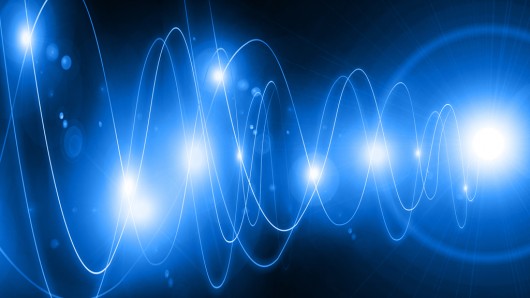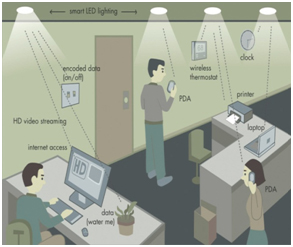
Wifi… it’s in coffee shops, hotels and even fast food restaurants today. It’s expanding so quickly that some people predict you won’t need a cell phone plan in the USA by 2020 due to how widespread the coverage will be. No more stealing it from the people next door or walking around looking for a signal because you’re about to overrun your plan limit. At the same time you have probably gotten frustrated at the slow speeds you face when more than one device is tapped into the network. As more people add more devices with access to the wireless internet, clogged airwaves are going to make things unbearable. Even your favorite games will suffer no matter how great a plan you pay for. It is inevitable.
With that lump of depressing news out, a German physicist named Harald Haas, who happens to be the chair of mobile communications at the University of Edinburgh, has come up with a solution he calls:
“data through illumination –taking the fiber out of fiber optic by sending data through an LED light bulb that varies in intensity faster than the human eye can follow. “
It’s the same basic principal as the infrared remote control for your television or stereo but, far more powerful. Haas says his system (which he refers to as D-LIGHT) can produce data rates faster than 10 megabits per second. FYI The USA’s F.C.C. rates basic broadband at 4 megabits coming in and 1 going out (of your device), that baseline makes it a fair amount faster than the average rabbit. Current fiber optic systems require a cable like the modems of the 1980’s and 90’s and an adaptor in your machine. The light travels through a special plastic conductor like electricity flows through a metal wire. The D-Light system will eliminate the need for that cable but keep the extreme high speeds by creating a beam of light (invisible to the naked eye) that will connect with your device. Although Hass’ group has produced working prototypes of the technology there are still hurdles. Since D-Light technology needs a direct line of sight to function correctly, the challenge of being able to move freely while staying connected is still there. The next hurdle according to the research group is to produce a transceiver unit that will track and maintain the connection on its own. Communication through a beam of light made possible by the accelerated development of LED’s. I only hope my life is long enough for me to be able to see the first Star trek-style transporter be born.
Like many people Mr. Haas sees a future where data for laptops, smart phones, and tablets is transmitted through the light in a room. No, it’s not meant to replace wifi. A quick thought of our world shows how useful it could be. How many places is it “illegal” to use your wifi device? Hospitals, airplanes and even some government buildings will not allow you to have your device on due to the sensitivity to radio waves. Light doesn’t affect these things.
If you’re curious about the inner workings of this technology I highly encourage you to check out the link below and the references listed. The one question that floats up here is… what about security? How would you keep yourself safe from would-be identity thieves or worse? According to Haas “security would be snap – if you can’t see the light, you can’t access the data”. That’s all well and good on paper. I guess this means new technology for window coatings and black out drapes too? I don’t know how I’d feel if I had to isolate myself in order to logon to social media. What do you think? What’s the next step?
Bibliography
Sana, G. R. (2012). Li-Fi (Light Fidelity)-The future technology In Wireless communication. International Journal of Applied Engineering Research, Vol.7 No.11. Retrieved from http://www.academia.edu/4940306/Li-Fi_Light_Fidelity_-The_future_technology_In_Wireless_communication
Savage, N. (2014, November 20). Li-Fi Gets Ready to Compete With Wi-Fi – IEEE Spectrum. Retrieved 3 March 2015, from http://spectrum.ieee.org/telecom/internet/lifi-gets-ready-to-compete-with-wifi
Singh, R. K. (2015). Li-Fi-like System intended to bring 100-Gbps Speeds Straight to Your Computer. Retrieved from http://www.techworm.net/2015/02/li-fi-like-system-intended-bring-100-gbps-speeds-straight-computer.html
Citation (Sana, 2012), (Savage, 2014), (Singh, 2015)





